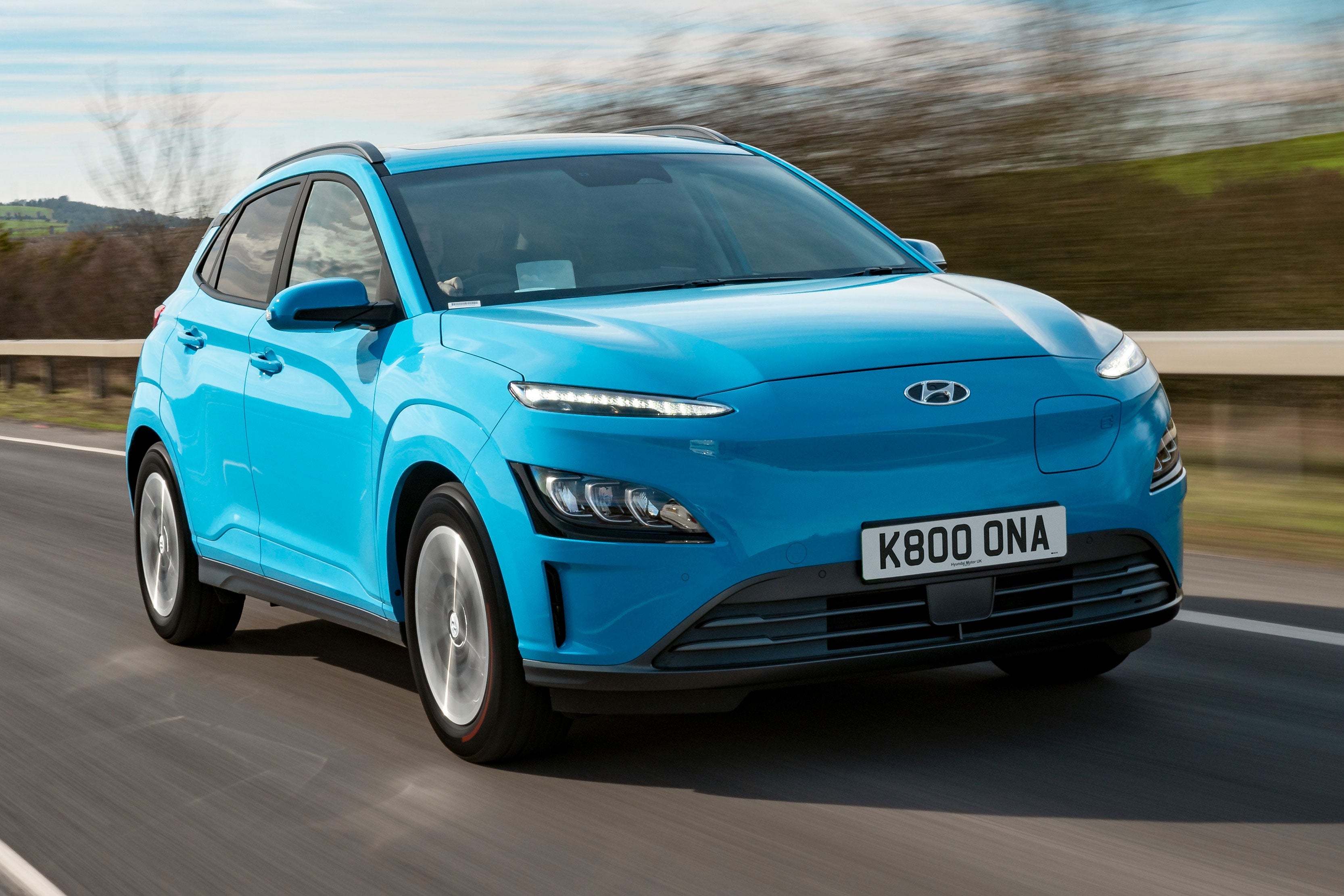Hyundai Kona Electric (2019-2023) Review
Written by Andrew Brady
Quick overview
Pros
- Impressive 279-mile electric range
- Easy yet fun to drive
- Transferable five-year/unlimited-mileage warranty
Cons
- Not as practical as alternatives like the Kia e-Niro
- Interior could be more stylish
- Little chance of a second-hand bargain
Overall verdict on the Hyundai Kona Electric
"The Hyundai Kona Electric is one of the best electric cars on the market, as you'll read in this review. It’ll travel far enough between charges to keep most of us happy, and you get a load of standard equipment for your money. It’s so desirable that actually finding one might be tricky, and you’ll pay a premium for it."
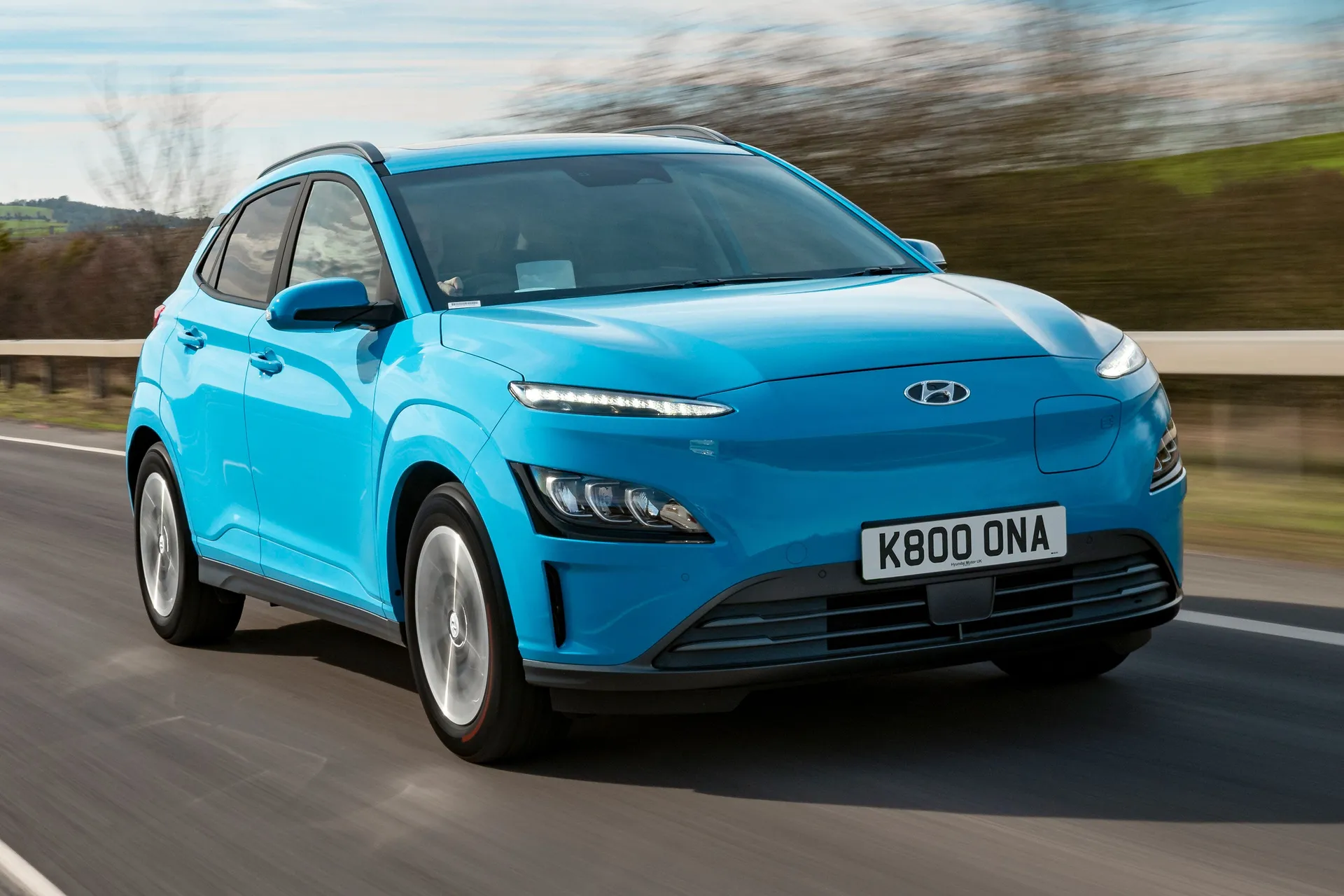
The Hyundai Kona Electric could be the car that convinces you that now is the time to go electric. It’s relatively affordable (lightly-used examples start below £30,000), can travel a useful distance between charges (up to 279 miles) and it comes with an extensive list of equipment for the cash. It's well worth considering next to the standard Hyundai Kona.
Chuck in a long warranty and a desirable small SUV body style and the Kona Electric is - on paper at least - about as close to being one of the best electric cars going.
It’s easy to see why demand for the Kona Electric is so overwhelmingly huge. At one point, Hyundai had to take it off sale as waiting times extended beyond a year. The range has now been streamlined to allow faster deliveries and reduce the wait, but you’d still be wise to skip the queue by looking for an as-new previously-owned example.
In typical electric car fashion, the Kona Electric is a lot of fun to drive. It does without a conventional gear selector, instead using four buttons to allow you to select drive, reverse, neutral or park. You’ll have to recalibrate your mind if you’ve not driven an EV before - it’ll accelerate instantaneously (there’s no waiting for the turbo the spool up or the transmission to find an appropriate gear), and there’s little noise to give you an idea of how fast you’re travelling.
You can slow down by simply lifting off the accelerator pedal. Increase the regenerative braking if you want to reduce your reliance on the brakes, but it’s not as severe as the Nissan Leaf (which has a one-pedal driving mode).
All this means the Kona Electric’s in its element around town. It’ll down in and out of traffic in a manner that’d look antisocial in a noisy combustion-engined car, while the slightly higher than normal seating position gives you a good view of the road ahead. Its relatively compact dimensions mean it’s quite an easy car for squeezing in and out of gaps, too.
While there’s plenty of power to get up to motorway speeds, you’ll find that the remaining range starts to fall quite quickly if you’re hustling in the outside lane - but that’s true for most electric cars. It’s not as refined as alternatives here, with quite a significant amount of wind and road noise.
The cabin feels modern, but it’s far from as futuristic as the new Honda e. Premium and Premium SE models come with a 10.25-inch infotainment system which is simple to operate, helped by useful shortcut buttons alongside the digital display. It looks sharp with clear graphics and fast responses, while Apple CarPlay and Android Auto are welcome standard features.
The Hyundai Kona Electric’s interior isn’t as plush as the MINI Electric, either. You’ll find a few below-par materials (the plastic on the centre console, for example) and it doesn’t look particularly attractive. It’s not offensive, though, and it’s logically laid out. You’ll find it easy to get comfortable, too, thanks to plenty of adjustment in the seats and steering wheel.
Rear space isn’t great. Adults will find it feels pretty tight back there, without a great deal of legroom. And the boot’s pretty small, too, with the batteries and charging cables leaving just 332 litres of space - less than in a Hyundai Ioniq Electric or Volkswagen e-Golf. You may wish to look at the Kia e-Niro if practicality’s important.
Still, these minor gripes aside, the Hyundai Kona Electric is a hugely impressive car. You won’t get a bargain - strong demand will see to that - but you will get an electric car that’ll be cheap to run, reliable, fun to drive and - the sticking point for many buyers - able to travel fairly long distances between charges.
Looking for a used car for sale? We've got 100s of Hyundai Approved Used Cars for Sale for you to choose from, including a wide range of Hyundai Konas for sale. If you're looking for the newer version, you need our Hyundai Kona Electric review.
Is the Hyundai Kona Electric right for you?
If you’re wondering about switching to electric but need to cover relatively long journeys without plugging in, the Kona Electric’s 279-mile range should give you some peace of mind. It’s not as practical as the bigger Kia e-Niro but it’s easy (and fun) to drive and comes with a lot of standard equipment.
What’s the best Hyundai Kona Electric model/engine to choose?
Don’t bother hunting out a 39kWh model unless you find one that’s particularly cheap - the 64kWh is much more common and more desirable. It’s worth looking for the Premium trim level for the bigger infotainment screen and navigation. The Premium SE comes with some very appealing features, but you’ll pay the price.
What other cars are similar to the Hyundai Kona Electric?
You could also look at the Kia e-Niro. It shares the Kona’s tech, but it’s bigger and more practical (and costlier). Then there’s the Kia Soul EV or Hyundai Ioniq - two more brilliant Korean electric cars. The BMW i3 is a strong competitor, as well as the Volkswagen e-Golf and upcoming ID.3. The Nissan Leaf is a popular choice and represents good value for money, but it’s far from being ahead of the game.
Comfort and design: Hyundai Kona Electric interior
"While the standard Hyundai Kona is quite an affordable crossover SUV, the Kona Electric is one of the most expensive models the firm sells. That means it’s got quite a few unique touches to lift the cabin over the rather drab affair used in the standard Kona."
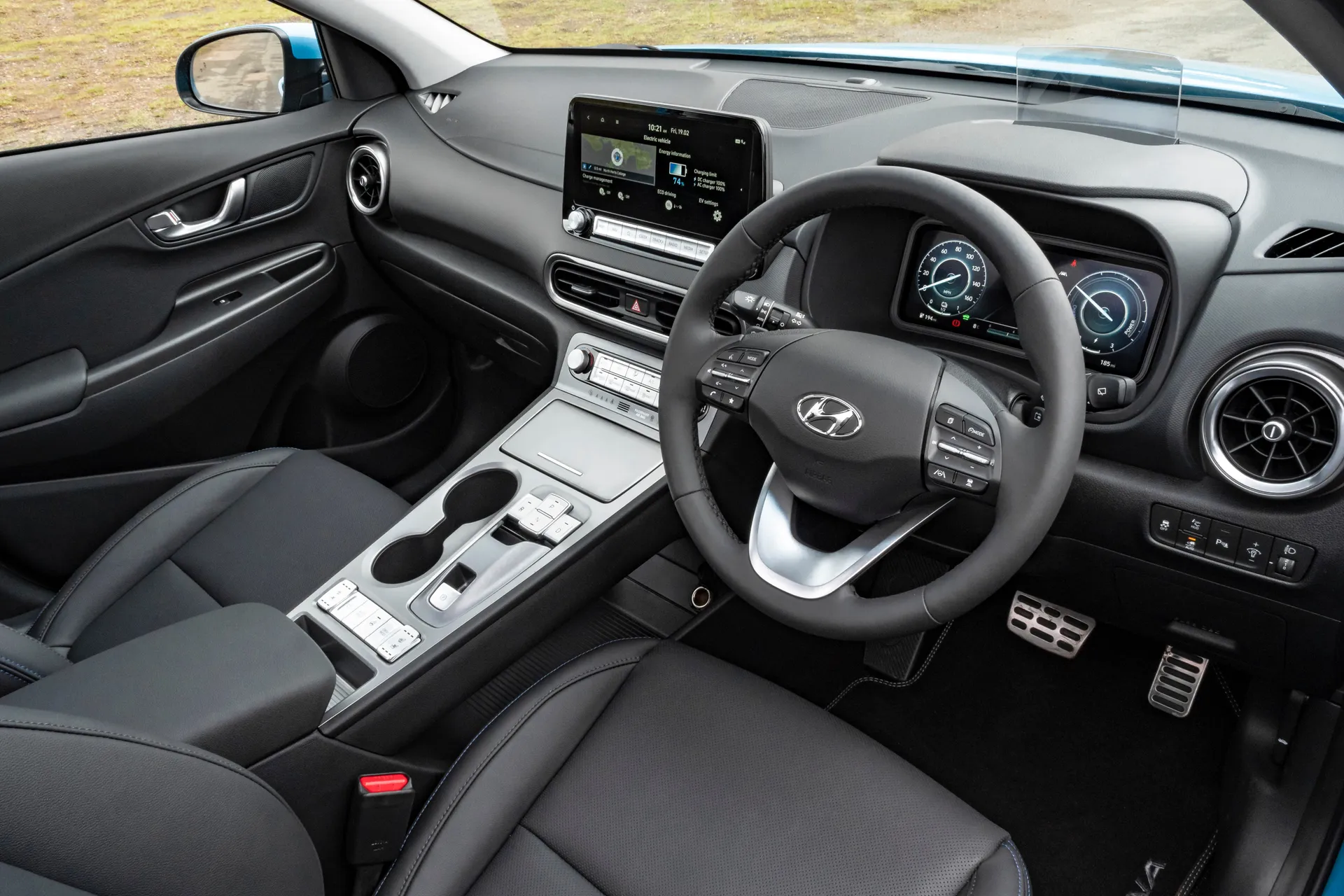
These include a silver centre console, with space underneath it for extra storage, while buttons rather than a conventional automatic gear shifter makes the Kona Electric feel a bit futuristic. It doesn’t feel as premium as cars like the BMW i3, though, and you’ll find some harsh materials if you go poking around the cabin.
Quality and finish
The Hyundai Kona Electric has an excellent level of fit and finish, however the quality of the material used isn't so great. There's a plasticky feel not just to the actual plastic, but also to the steering wheel that's supposed to be wrapped in leather. The metal-look plastics don't do the team any favours, but at least you get sports-car like circular air vents and metal-finished pedals.
Infotainment: Touchscreen, USB, sat nav and stereo in the Hyundai Kona Electric
It's worth upgrading to the Premium or Premium SE model for the bigger infotainment display, which is simple to use with clear graphics as well as access to live features such as real-time traffic information and speed camera alerts. Apple CarPlay and Android Auto are standard, too. A eight-speaker stereo is standard and you get at least one USB plug as standard.
Space and practicality: Hyundai Kona Electric boot space
In terms of space, the Kona Electric isn't the most practical choice - particularly if you’re planning to use it as your main family car. It's fine up front, with loads of adjustment in the driver's seat and steering wheel meaning you'll soon find a comfortable seating position. Adults won't be quite so happy in the rear, however. Headroom is reasonable, but it's pretty tight in terms of legroom.
The Hyundai Kona Electric's boot is pretty small, too - the batteries eating into an already quite small luggage area. By the time you've loaded the charging cables, you're left with just 332 litres of space. The rear bench splits 60:40 and drops easily, but access isn't great - with a high lip over the rear bumper.
In terms of dimensions, the Hyundai Kona Electric is 4180mm long, 1800mm wide and 1570mm tall.
Handling and ride quality: What is the Hyundai Kona Electric like to drive?
"If you haven’t driven an electric car before, you’re in for a treat."
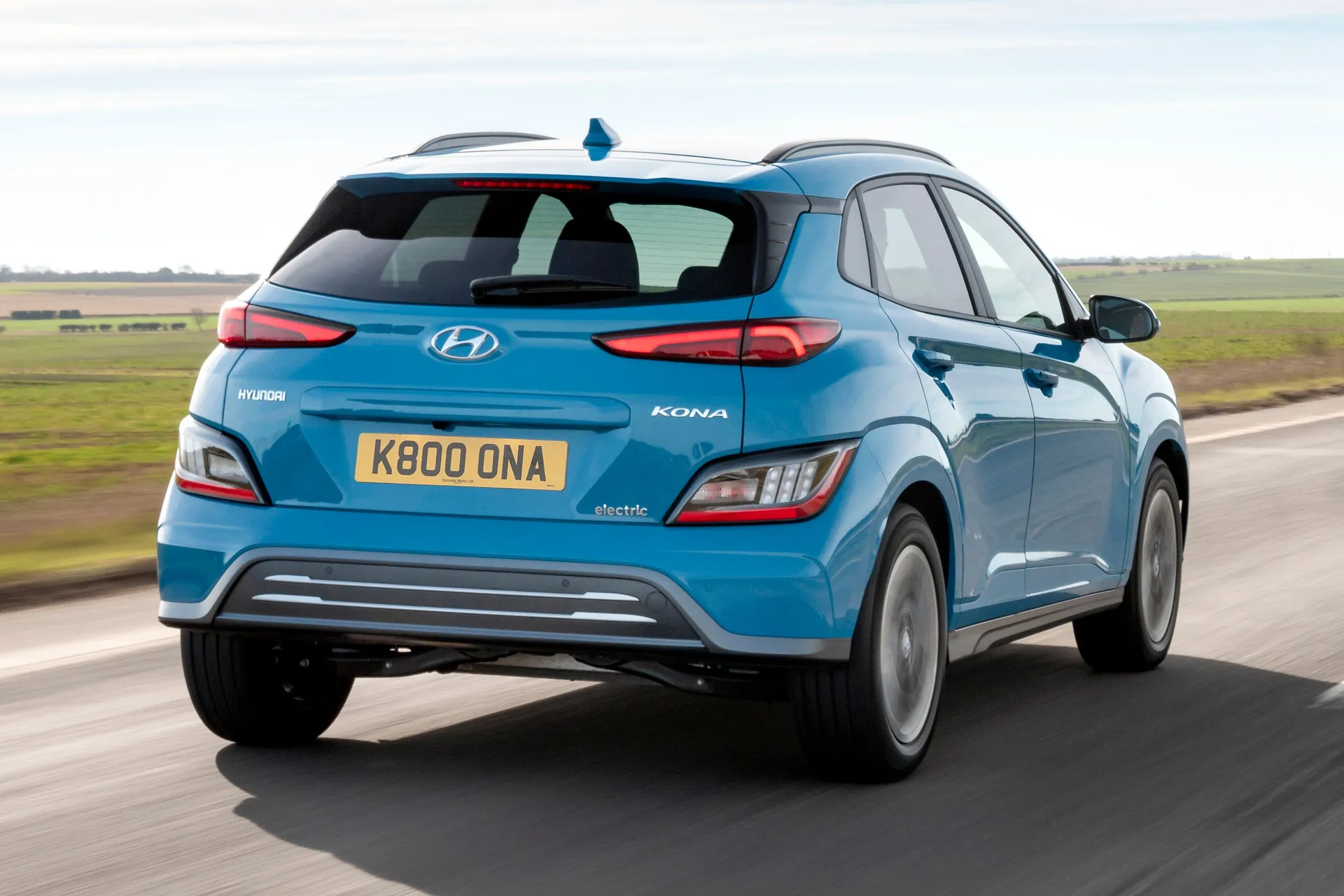
The Hyundai Kona Electric surges forward in near-silence, making it a very relaxing car to drive. It’s particularly good around town, where there’s no grumble from a petrol or diesel engine and you don’t have to worry about changing gears.
What engines and gearboxes are available in the Hyundai Kona Electric?
Hyundai Kona Electric buyers were initially given the choice of two different battery sizes: 39 or 64kWh. While the smaller battery pack was competitive with rivals (it provided a range of 180 miles between charges), most people paid the extra money for the 64kWh version with its 279-mile range.
As such, Hyundai dropped the 39kWh model in the UK in January 2020, making it very rare on the used market. That’s fine as the 64kWh model is the more desirable option. As well as being able to travel further between charges, it’s quicker, too - accelerating from 0-62mph in 7.6 seconds.
Refinement and noise levels
They Hyundai Kona Electric is almost silent driving around town, even when you accelerate hard away from the traffic lights. At faster speeds, you'll hear some wind rustle from the wing mirrors and A pillar but nothing dramatic.
Safety equipment: How safe is the Hyundai Kona Electric?
The Hyundai Kona has a five-star NCAP safety rating and we'd expect the Kona Electric to be just as tough.
Safety features are numerous. The Hyundai Kona comes with active cruise control that can accelerate and brake the car, lane assist which keeps the car in lane and automatic emergency brakes that can stop the car when they sense an imminent collision. You also get two Isofix points on the back seats.
Maximum EV range in the Hyundai Kona Electric
All new Hyundai Kona Electrics come with a 64kWh battery, giving them a 279-mile range. Early in the model's life, Hyundai sold a 39kwh Kona Electric – it has a range of around 175 miles.
Charging times: How much does it cost to charge the Hyundai Kona Electric?
"Once you’ve forked out the cost of buying a Hyundai Kona Electric, it’s a very affordable car to run."
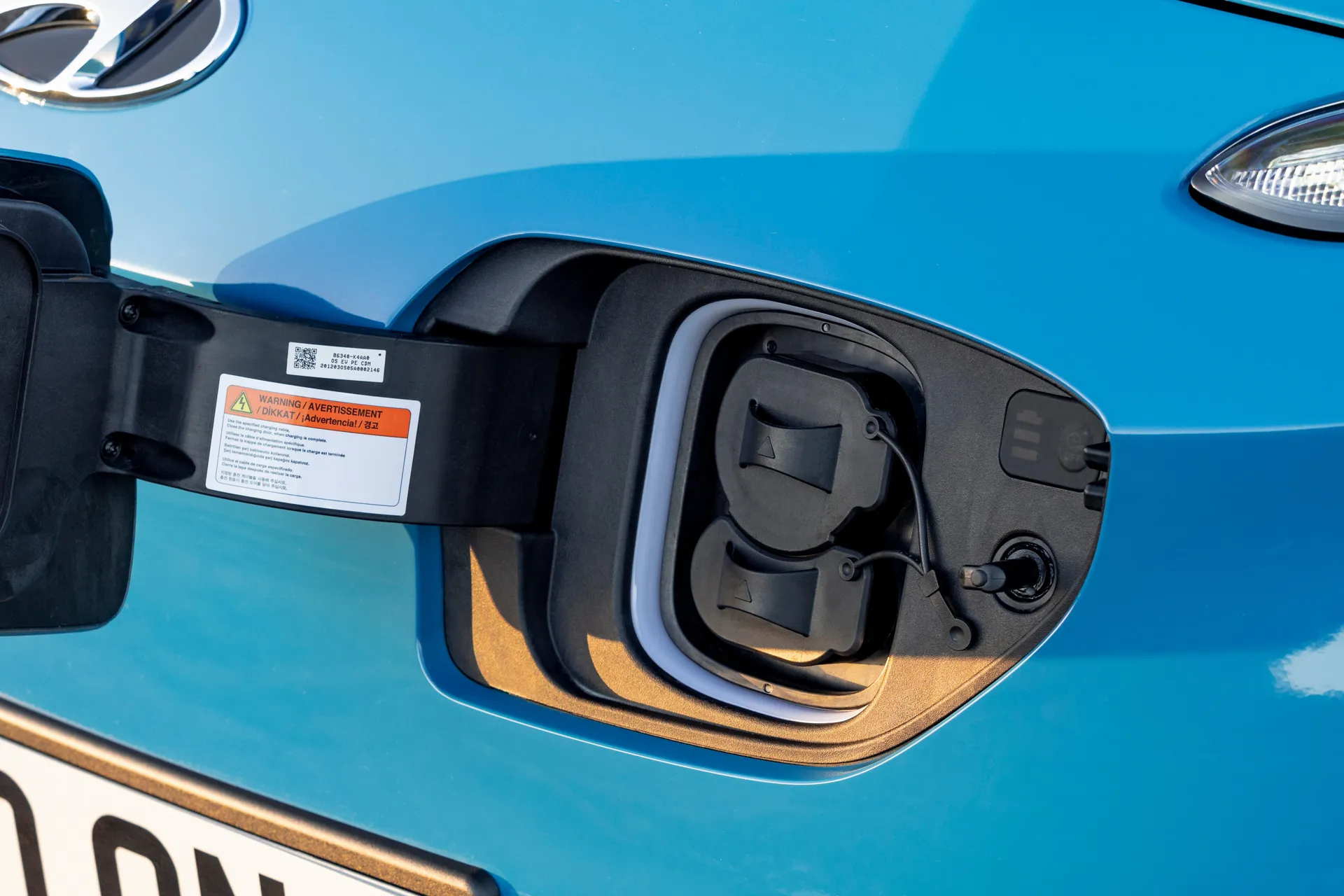
The biggest attraction is never having to pay for a tank of petrol or diesel again. Rising electricity tariffs mean running an electric car like the Hyundai Kona Electric isn't as cheap as it once was, but it's still not going to break the bank as much as a traditional combustion-engined car.
The most affordable way of charging any electric car is by plugging it at home, ideally overnight on an off-peak tariff. Octopus Energy, for example, allows you to charge overnight at a rate of 7.5p per kWh - in theory, that works out at less than a fiver to fully charge the Kona Electric. In reality, though, you won't be able to fully charge the Kona Electric within Octopus Energy's six-hour off-peak period (or four hours, depending on the tariff you're on) - but you should still be able to fully charge the Kona for around £10 - £15, if you're savvy.
You can charge a Kona Electric using a three-pin plug at home but it’ll take about 30 hours to do so fully. We’d recommend having a home charger installed - a 7kW unit will charge the Kona Electric entirely in around 11 hours, meaning you can just get into the habit of plugging it in overnight.
On a longer journey, a 100kW rapid charger will take the Kona Electric from 10 to 80 per cent range in about 45 minutes. This is a much more expensive way of charging, though - with some companies charging as much as 70 per kWh for a quick top up, you could pay more than £30 for a 70% charge.
How reliable is a Hyundai Kona Electric?
The Hyundai Kona Electric has fewer moving parts to break than a standard Kona, it also doesn't use engine oil or have an exhaust that'll need replacing. Meanwhile, its regenerative brakes take the pressure off the normal brake discs and pads, meaning they won't need replacing as often.
You can expect the Hyundai Kona Electric to be reliable, thanks to a solid fifth-place showing in our sister website, Honest John's, Owner Satisfaction Index, which was topped by Lexus. All Hyundai's come with a five-year/unlimited-mileage warranty and the Kona Electric's battery is covered by an eight-year, 125,000 mile warranty.
Insurance group and costs
One of the advantages of buying a 39kWh Hyundai Kona is that it will be cheaper to insure with SE versions sitting in group 22, while Premium models sit in insurance group 23. Go for a 64kWh version and you're looking at group 26 for a Premium model or group 27 for a Premium SE car.
VED car tax: What is the annual road tax on a Hyundai Kona Electric?
You won’t pay anything in car tax (VED) and, if you venture in Central London, you’ll save on Congestion Charge fees too. You might even be eligible for parking permit discounts.
How much should you be paying for a used Hyundai Kona Electric?
You can pick up a 39kWh version of the Hyundai Kona Electric with a hand full of miles on the clock for less than £25,000. Spend around £27,000 and you'll be able to get your hands on the 64kWh model which has more performance and a longer range, although it will have at least 60,000 miles on the clock. Hunt about and you'll find preregistered cars with a healthy £3000 savings on list price – yours for around around £36,000.
Trim levels and standard equipment
"There are three trim levels for the Hyundai Kona Electric: SE, Premium and Premium SE."
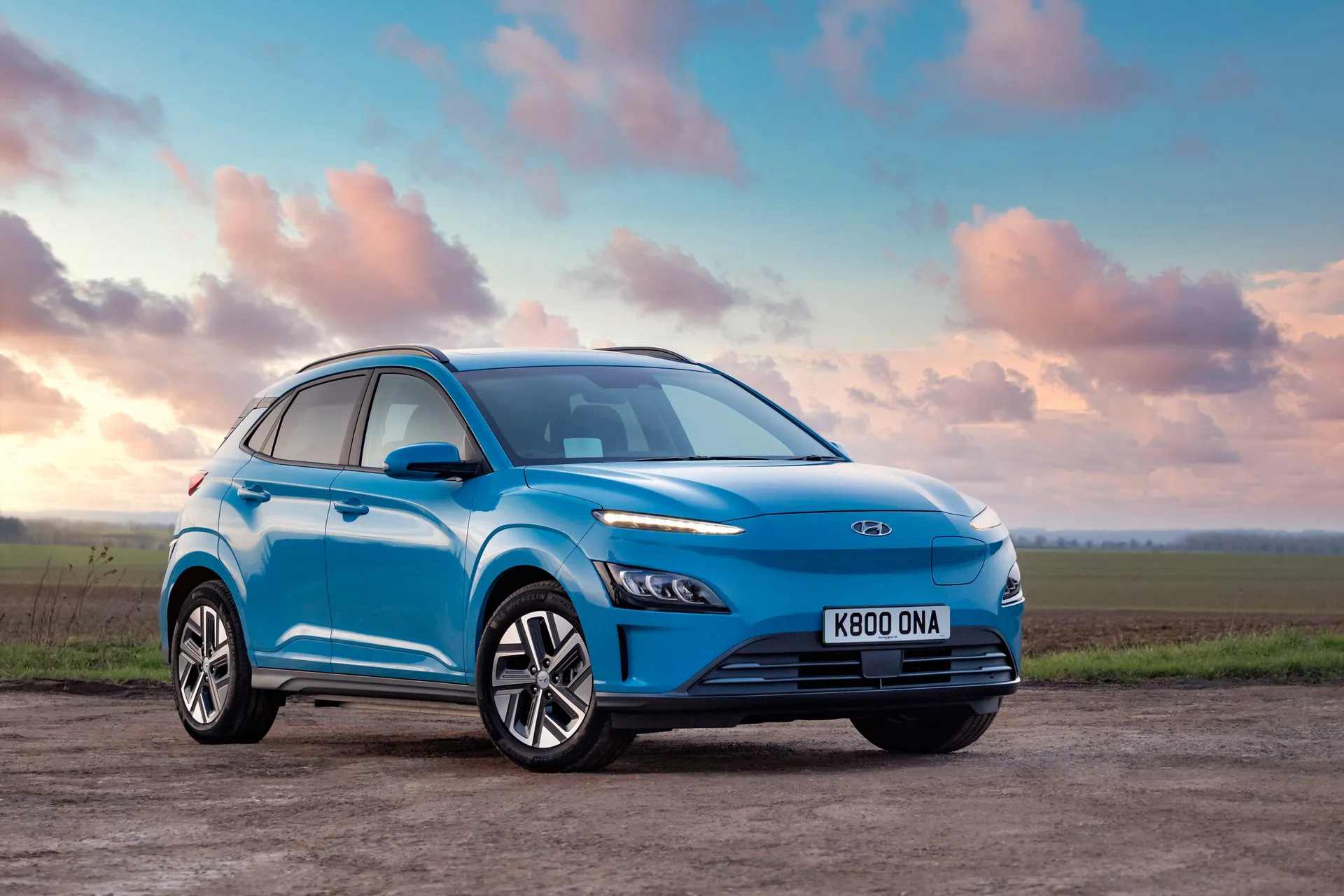
The Hyundai Kona Electric SE comes with a seven-inch touchscreen media system (with Apple CarPlay/Android Auto), 17-inch alloy wheels, climate control and a reversing camera.
The Premium features a bigger 10.25-inch display with navigation, as well as a premium eight-speaker sound system. It also adds a host of driver assistance technology, such as Hyundai’s Lane Follow Assist, Rear Cross Traffic Alert and an Intelligent Speed Limit Warning. Front and rear parking sensors are standard too, as well as front and rear parking sensors and privacy glass.
Topping the range is the Premium SE, which builds on the Premium’s spec with things like leather seats with electrical adjustment in the front, heated and cooled front seats (heated in the rear), a heated steering wheel and a head-up display. It also gets full LED headlights with high-beam assist.
Ask the heycar experts: common questions
How much is a Kia Kona Electric?
How much does it cost to charge a Kona Electric in the UK?
Should I charge my Hyundai Kona Electric to 100%?
Get our latest advice, news and offers
Keep me updated by email with the latest advice, news and offers from heycar.
By submitting you agree to our privacy policy
